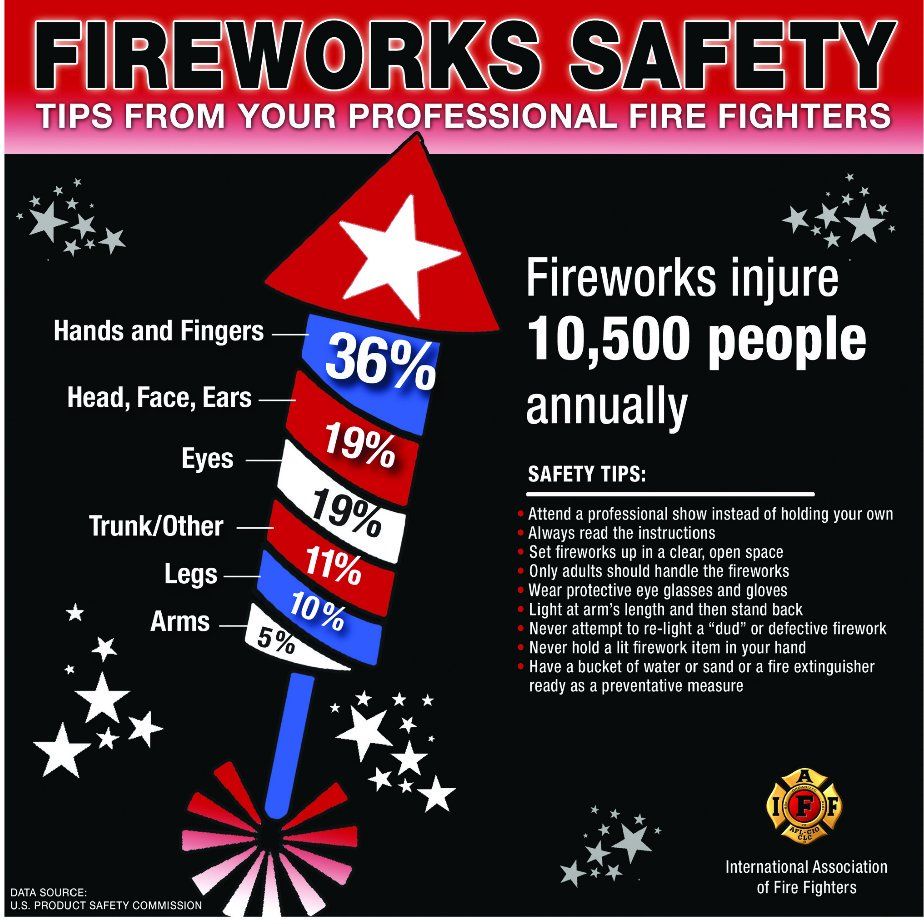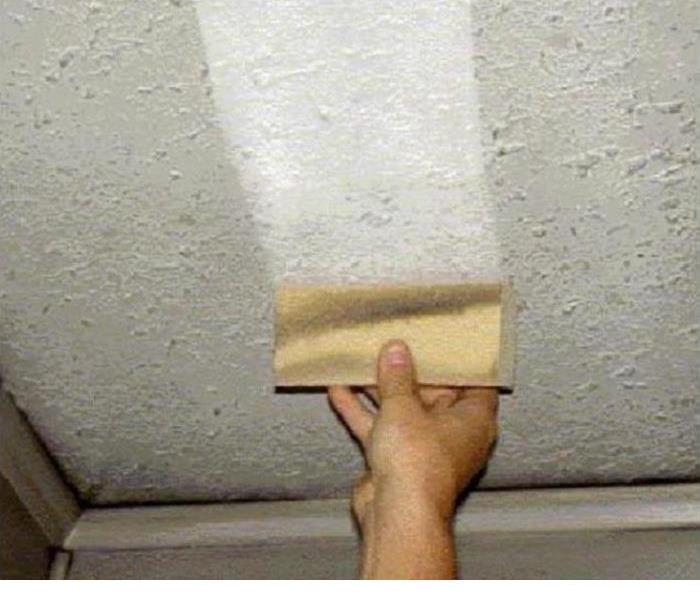Recent Fire Damage Posts
Lightning Fires
4/13/2022 (Permalink)
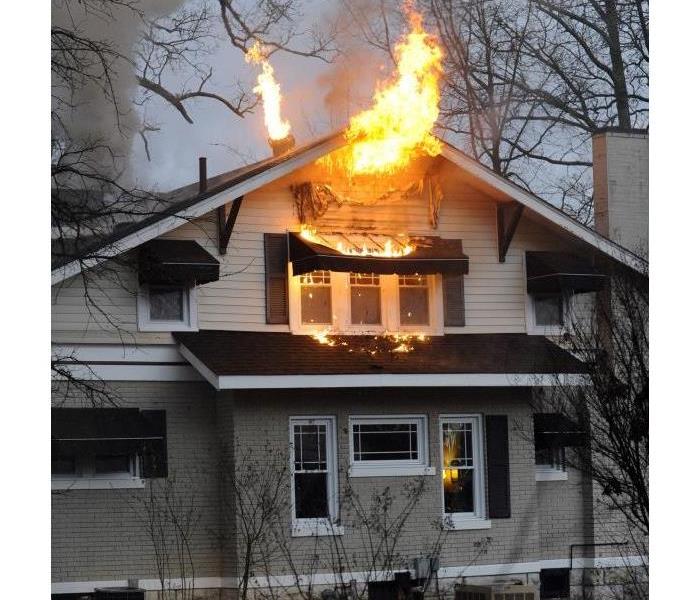 Lightning struck this home's attic causing it to go up in flames.
Lightning struck this home's attic causing it to go up in flames.
House fires caused by lightning strikes are probably more common than you would think. Insurance companies estimate home and commercial losses caused by lightning that are worth billions of dollars every year.
If you are in your home when the lightning strikes, you will hear a loud explosive sound. In older homes, it is likely that your house and everything in it will shake. In newer homes, most of them have been built to withstand and absorb a lightning strike, reducing the shake. However, the exterior damage and shaking is usually minor compared to the aftermath, which is the main concern.
The tough part about lightning striking your home is that if a fire is started, you may not notice until it is too late. The fire could start in an attic or in the walls for instance. You should contact your local fire department right away, even if you don't see any smoke or fire. If the fire department clears your home, the next thing you should do is follow up with an electrician to inspect your home and make sure no fire hazards were created by the strike. Unfortunately, there is no way to predict if or when a lightning strike will hit your house, but being prepared and knowing what to do in the aftermath will go a long way.
Smoke Damage
4/5/2022 (Permalink)
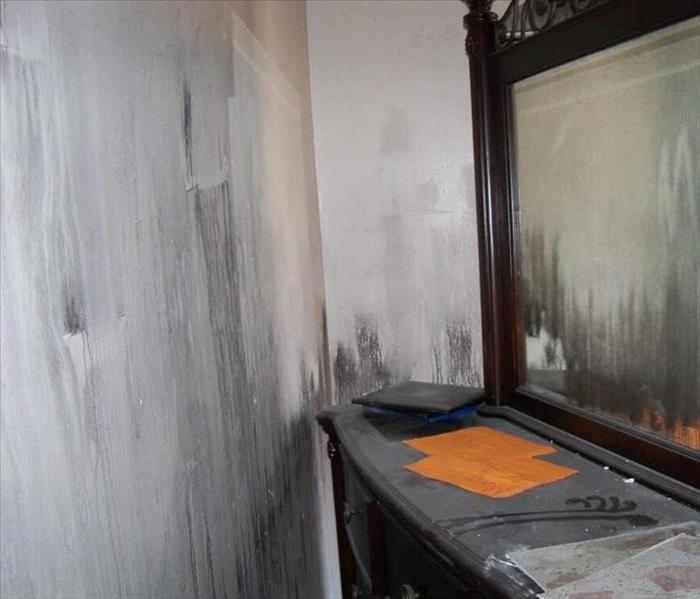 A fire caused soot to stain the drywall and leave behind a residue.
A fire caused soot to stain the drywall and leave behind a residue.
When a fire occurs in your home, there is more too it than just the flame you see. Even in a minor fire that is put out rather quickly, you still have to worry about the damage that smoke and soot can cause. Often times smoke and soot can creep into cavities in your home causing damage that may not be easily seen.
There are two different types of smoke, wet and dry. Below is some information about both kinds and where they may occur:
Wet Smoke -This is most commonly found on materials such as plastic and rubber. Wet smoke is more likely to occur at low heat, causing smoldering and melting. Wet smoke is often more difficult to clean.
Dry Smoke -Dry smoke is associated mostly with paper and wood. These materials burn faster and at higher temperatures. Due to their intense heat, they give off more smoke.
It is important to have a trained SERVPRO technician out to test which type of smoke has occurred, as this will determine how they approach the restoration process.
The Dangers of Space Heaters
1/28/2022 (Permalink)
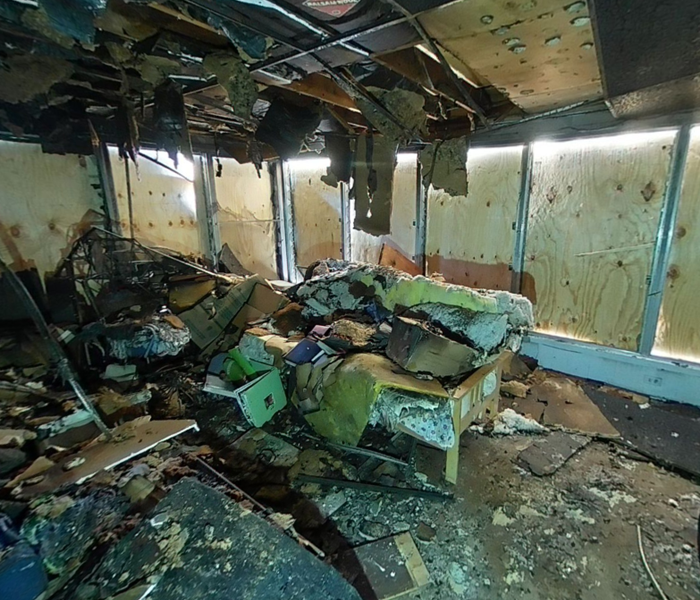 The fire started directly below this unit.
The fire started directly below this unit.
Space heaters, although very effective and convenient, have the potential to wreak some havoc. Space heaters are capable of overloading circuits, leading to fires. They can also easily start clothes or any other type of linens on fire. This was the case for one home, as their space heater on the first floor caught on fire while no one was in the room. By the time it was discovered it was too late, the room was up in flames and they needed to evacuate. The two rooms effected most were the room it started in and the room directly above it, as shown in the picture. The rest of the home suffered severe smoke damage and SERVPRO was called in to help them pack up their belongings and then begin to work on cleaning the walls and ceilings inside the home to remove the remaining soot. It is important to remember that if you must use a space heater, never leave it unattended and keep it away from all things flammable.
Fire in Evanston
12/17/2021 (Permalink)
A fire in the furnace room of an Evanston home caused significant damage in the basement as well as smoke damage throughout the home. The picture below shows plastic melted to the wall as well as the ash that followed. SERVPRO was called in to assess the damage and begin the process of restoring the home. There was damage to the drywall in the room where the fire started as well as the room next to it. Because it was damaged, it needed to be removed and disposed of. There was no demolition required anywhere else in the home, however that does not mean the work was done. Due to the damage from the smoke, the house needed to be cleaned from top to bottom, this included ceilings, walls, floors and content. This was no easy task, but SERVPRO put their best effort forward and got the job done as they always do!
Top Causes of Winter Fires
12/17/2021 (Permalink)
There is a lot of excitement associated with the holiday season, but it is important not to forget about the dangers that come with it. This blog will highlight the top 4 causes of winter fires so you can better avoid them.
1) Candles - Although they smell good and can make for nice decorations, candles have proven to be a major fire hazard. From 2012-2016, there were an estimated 8,200 candle fires with December being the peak month.
2) Smoking - It might be cold outside, but taking your smoke breaks inside is not the answer. Smoking materials such as cigarettes, cigars and pipes are the leading cause of fire deaths in America.
3) Electrical Lighting - Ensuring your Christmas lights are safe and working properly can save you a lot of trouble in the long run. Look out for loose bulbs or frayed wires. It is also important that you do not overload an outlet or power strip.
4) Christmas Trees - Whether you have a real tree or an artificial tree, it is important that you keep it away from combustibles such as candles, fireplaces, radiators, etc. Its important to keep your tree fed with water to ensure it doesn't dry out, trees are extremely flammable when dry.
Fireplace Safety Tips
9/21/2021 (Permalink)
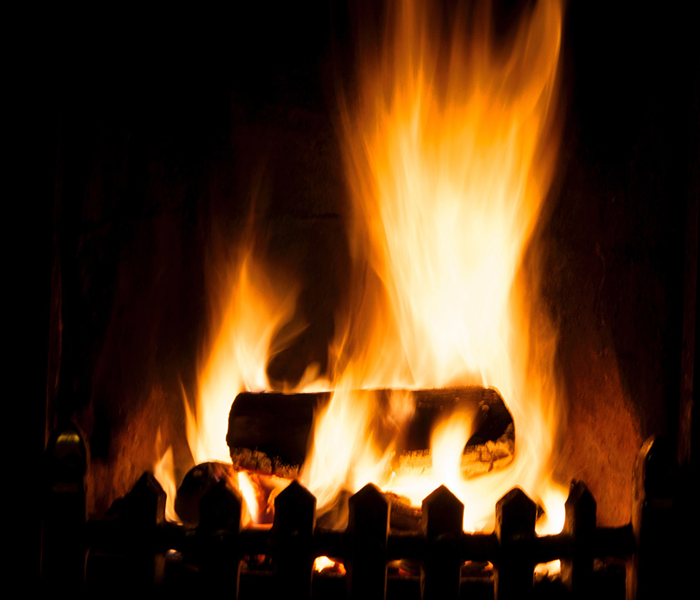 Fireplace safety is important to protect your home.
Fireplace safety is important to protect your home.
As summer winds down and the cooler weather starts heading our way, there is nothing better than cozying up to your fireplace with a good book. Here are some helpful tips to keeping you safely warm this fall and winter.
- Get your chimney inspected each year to make sure that it is safe
- Hire a chimney sweep to clean out your chimney every fall
- Repair any cracks in fireplaces
- Use fireplace screens to keep sparks and debris inside the fireplace
- Do not ever use gasoline to start a fire in the fireplace
- Never leave a fire unattended
- Make sure that combustible materials are not stored within three feet of your fireplace
- For natural gas fireplaces, get all connections and lines inspected before use each season
- Remember that outdoor fireplaces can be just as dangerous as indoor units, and observe all safety precautions when using them
It is also very important that members of your household know how to react in the event of a fire. It’s a good idea to review fire prevention and safety tips with your family every fall.
Heating Up
8/10/2021 (Permalink)
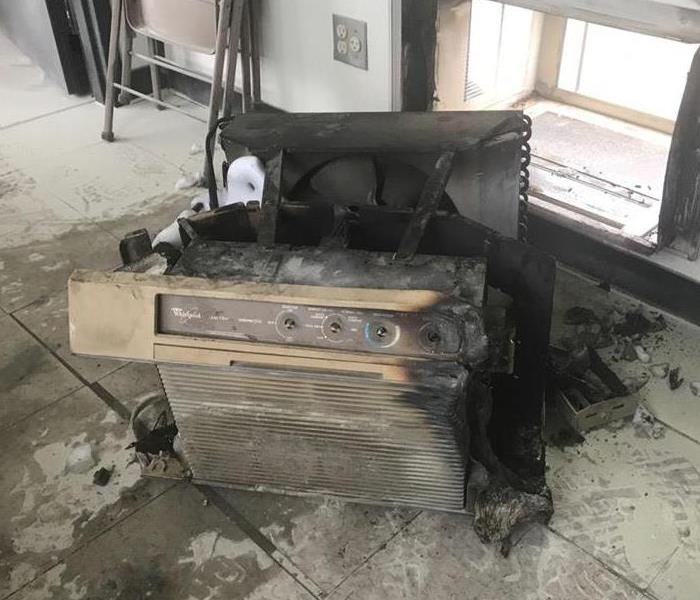 This AC unit caught fire and is completely destroyed.
This AC unit caught fire and is completely destroyed.
The weather is not the only thing that can be hot during the summer. Fires are very common during the summer months and can put a real damper on your summer festivities. Fires can happen for a number of reasons, but this blog is going to highlight some of the most common reasons a fire may start at your home this summer.
1. Smoking fires. Though they are common all year, they are especially common in the summer due to the lack of awareness when discarding a cigarette. Be careful not to discard into dry grass or near any flammable structures.
2. Air Conditioning fires. Faulty wiring is usually the cause of AC fires. Fires are most likely to occur when it is hottest outside, between 2-8PM.
3. Lightning fires. Lightning can strike your house and cause a fire to start. It is important to be aware of the weather and stay ready for anything to happen.
Fire Pit Safety
4/6/2021 (Permalink)
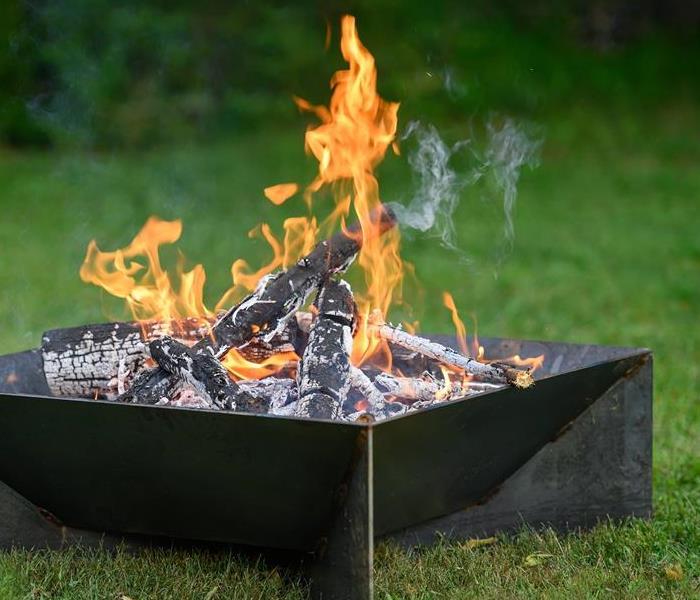 An example of a safe open fire.
An example of a safe open fire.
With the weather turning you might find yourself spending more time around the fire pit, here are some safe practice to save you and your home.
1. Never build your fire under an awning or any sort of overhang. This also includes trees, bushes, or umbrellas.
2. Always be ready to extinguish the flames. Whether that be when the party is winding down and it's time for bed, or in case of emergency. Make sure you have an extinguisher handy so your party doesn't crash and burn.
3. Never leave your fire unattended. Something as simple as a wind gust can put your entire home in jeopardy. Checking the wind conditions is another thing you should keep in mind when building your fire. If the wind is blowing towards your home or other flammable objects, you might have to save it for another day.
Barbecue Season
4/6/2021 (Permalink)
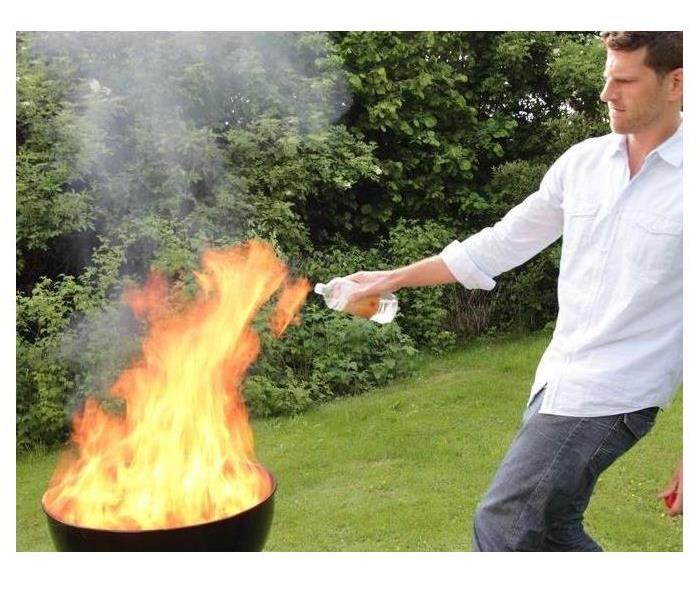 An out of control flame becomes even more dangerous if located near a structure.
An out of control flame becomes even more dangerous if located near a structure.
As the weather begins to turn for the better, there are few things that signal the sign of summer better than the first barbecue of the year. Although this is a joyous moment, that joy can turn to worry in a heartbeat. Here are some tips to ensure that you avoid any accidents and have a safe summer of grilling.
1. Make sure you grill outside and away from any structures. Avoid grilling under any umbrellas or awnings as they can quickly catch fire.
2. Provide your grill with a stable surface to stand on. Doing this ensures that your grill wont fall or be tipped over.
3. Check for propane leaks. Propane leaks are very dangerous and if undetected can lead to fire or explosion. The line can be checked by applying a solution consisting of soap and water to the valve where they connect. Then turn the tank on, if you see bubbles, there is a leak.
Space Heater Safety Tips
12/8/2020 (Permalink)
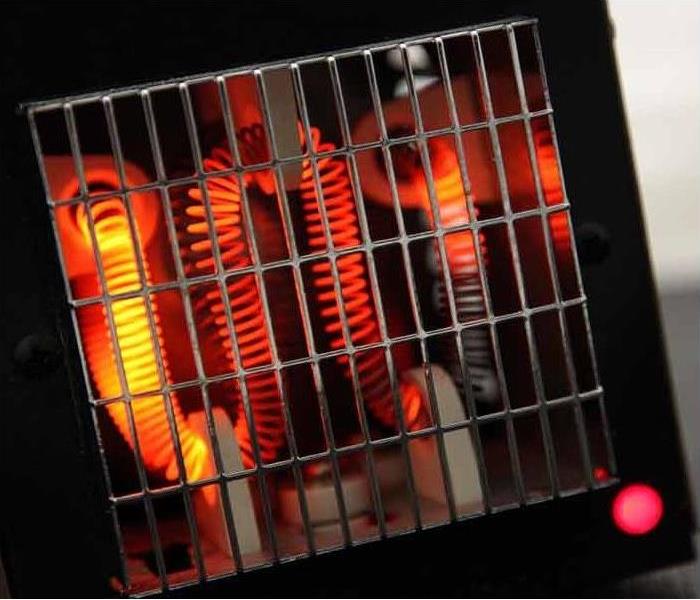 Space Heater Safety
Space Heater Safety
With winter upon us some of us may be sting to use space heaters in or around our homes. Negligence to a source of power that strong can lead to detrimental damages to your home or work space. So here are 3 safety tips in regards to your space heater.
1. Safety Features
Make sure to find out if your space heater has protection against overheating and that it is very sturdy. The last thing you want is for your space heater to fall over and directly touching a flammable object.
2. Plug Directly Into Outlet
One of the most common mistakes people make is that they plug the space heater into an extension cord or a power strip. This should never be the case as the space heater is going to be using a lot of electricity and if too many things are plugged in you risk overheating blown fuses and even electrical fires. The space heater should be plugged into its own outlet by itself.
3. Unplug and Turn off
When the space heater is not in use always make sure to turn it off and unplug it from the outlet. There is no sense in risking an accident when the heater is not in use.
Call the Fire and Water Professionals
12/2/2020 (Permalink)
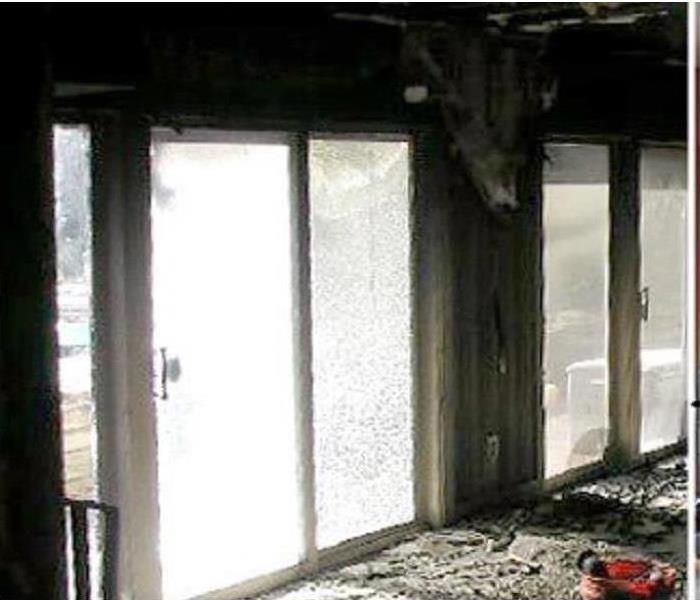 This house fire was caused by a cigarette and lead to extensive damage to the entire house.
This house fire was caused by a cigarette and lead to extensive damage to the entire house.
The fire was caused by a cigarette. The house was vacated and sat empty for a year. SERVPRO was asked to remediate the various damages to this home and provide the reconstruction for the portions we could not restore. As shown, the soot and smoke damage was pervasive. Rectifying these issues required the proper cleaning materials and significant elbow grease.
Here at SERVPRO of Woodridge/Bolingbrook, we know the devastation a house fire can bring to a family and we are eager to help.
Here's what you can do to minimize the damage before help arrives:
- Limit movement in the home to prevent soot particles from spreading
- Place clean towels or old linens on rugs and high traffic areas and upholstery
- Coat chrome faucets, trim, and appliances with petroleum jelly or oil
- Place aluminum foil or wood blocks between furniture legs and wet carpet
- Do not waste any walls or painted surfaces
- Do not shampoo carpet or upholstery
- Do not clean any electrical equipment
- Do not send clothing to a dry cleaner since improper cleaning may set smoke odor
In the event of a fire, call the fire and water professionals. Call SERVPRO of Woodridge/Bolingbrook.
630.771.1720
Home Safety and Fire Prevention
9/4/2020 (Permalink)
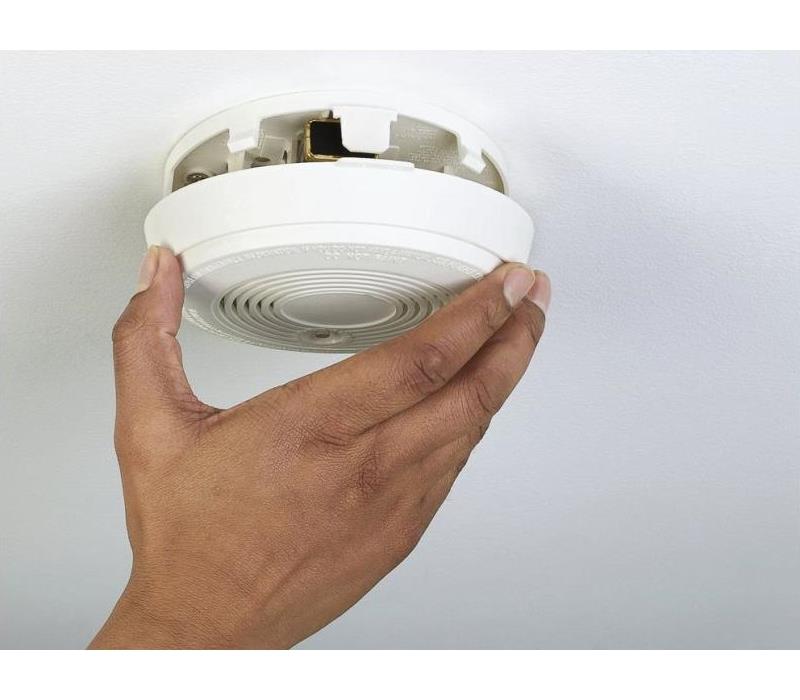 Battery Changing
Battery Changing
Fires can be devastating if severe enough. Not only are priceless items lost but your sense of comfort and stability is also at risk. There are all kinds of ways to be cautious and extra safe.
The number one thing in every home should be well maintained smoke detectors. On matters this serious you need to make sure that you are regularly testing them, changing the batteries, making sure they are working properly. You also need to make sure that you have the right number of smoke detectors.
Other things like planning an escape route, a family meeting point, and knowing who to call after 911. Always remember that you can never plan too much. Being prepared is never a bad thing.
Stay Safe, SERVPRO of Woodridge/Bolingbrook
(630) 771-1720
Summer Firework Safety
6/25/2020 (Permalink)
With the beginning of the summer and Fourth of July not too far off, we are gonna start seeing a lot of something: fireworks. While the National Safety Council does encourage everyone to enjoy firework displays put on by professionals, it is advised that we leave it only to the professionals. You really should not attempt to light off fireworks on your own, even if they are legal in your area. Fireworks can cause serious burn and eyes injuries to children and even adults if they malfunction or are not handled properly. SERVPRO of Woodridge/Bolingbrook knows the danger and devastation fireworks can cause if you end up accidentally starting a fire. To help keep you safe this summer, we have compiled a few tips on how to safely use or be around fireworks this summer if you choose to do so.
Safety Tips
- Never allow children to handle fireworks.
- Do not use fireworks if impaired by drugs or alcohol.
- When using fireworks or standing nearby, protective eyewear should be used.
- Never light fireworks indoors and use them away from people, houses, and flammable materials.
- Never point or throw fireworks at another person.
- Have a bucket of water or hose nearby.
- Do not try to make your own fireworks.
- Never relight a dud.
- Soak all fireworks in a bucket of water before throwing them in the garbage.
- Do not use illegal fireworks.
- Do not shoot fireworks in metal or glass containers.
In the tragic event of a fire from any cause, SERVPRO of Woodridge/Bolingbrook is always ready to help. With a quick response time and efficient work, we can make it “Like it never even happened,” in no time so you can get back to enjoying your summer.
Accidents Happen!
4/6/2020 (Permalink)
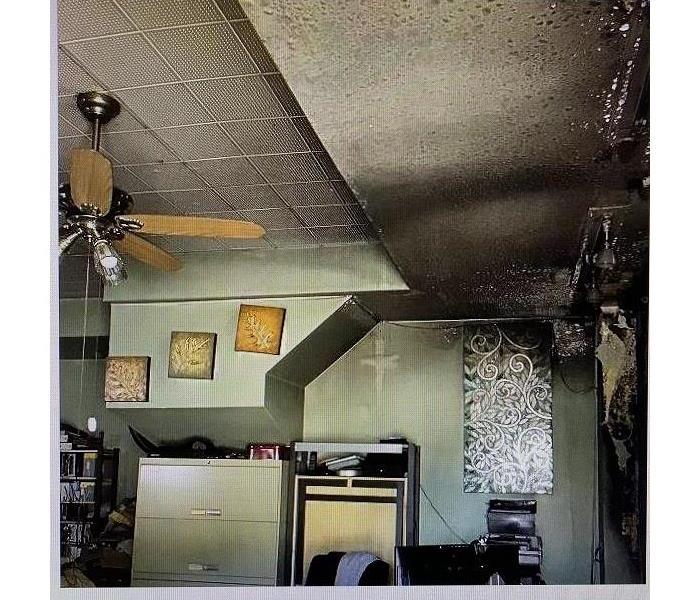 A commercial building after an electrical fire
A commercial building after an electrical fire
Accidents happen and here at SERVPRO of Evanston we completely understand.
Here are some emergency fire damage tips-
1. Limit movement in the home to prevent soot particles from being embedded into carpet and avoid tracking
2. Keep Hands Clean. Soot on hands can further soil upholstery, walls and woodwork
3. If electricity is off, empty freezer and refrigerator completely and prop doors open to help prevent odor
4. Wipe soot from metal kitchen and bathroom faucets,trim and appliances
5. Don't attempt to wash any walls or painted surfaces without first contacting you SERVPRO Franchise professional
6. Don't attempt to clean any electrical appliances (TV sets, radios, etc.) that may have been close to fire , heat, or water without first consulting an authorized repair service.
7.Don't attempt to shampoo carpets, rugs, or upholstered furniture without first consulting your SERVPRO franchise professional.
What's that smell?
4/6/2020 (Permalink)
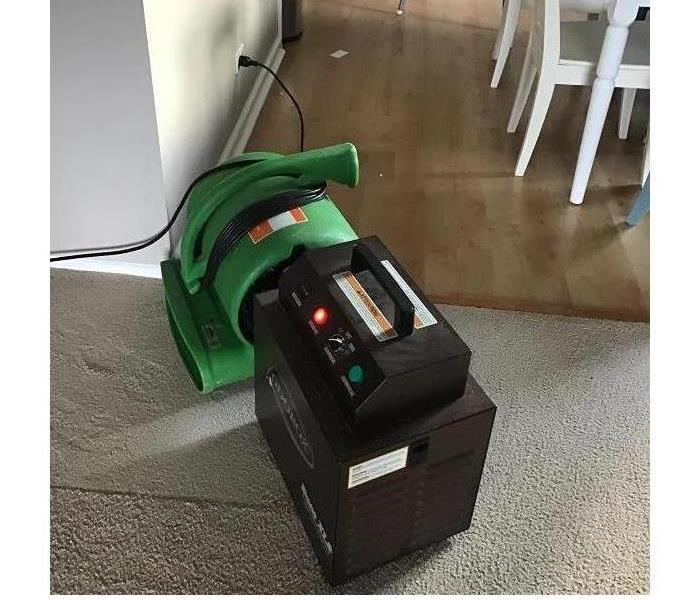 Deodorizing the air to get rid of the horrible smoke smell.
Deodorizing the air to get rid of the horrible smoke smell.
Sometimes in the case of smoke and fire damage it can travel through out a building in no time.
In this particular case , a fire broke out in the apartment on the first floor and all of the apartments on the floors above were affected with smoke and fire damage.
In cases like these we still take the same steps as if the fire happened in the apartment.
We take our time cleaning the contents and the structure to ensure there is no soot or harmful contaminants in the air.
We also place the proper equipment to help the process along, one of the important components is an air scrubber.
The air scrubber filters the dirty air via a hepa filter and releases clean breathable air.
We also use a hydroxyl which purifies the air and helps get rid of the smoke smell.
SERVPRO of Woodridge/Bolingbrook will ensure the job is done right and in a timely fashion to get you back living in your home as soon as possible.
New stone or did SERVPRO clean that!
12/11/2019 (Permalink)
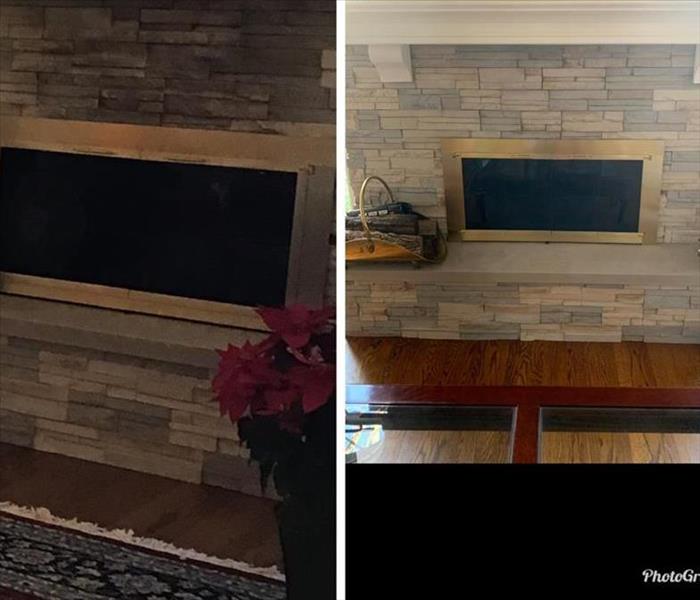 Smoke damage from the fireplace before, can seen the darkness above the fireplace. Then after pic where the darkness is gone.
Smoke damage from the fireplace before, can seen the darkness above the fireplace. Then after pic where the darkness is gone.
A home was affected in Burr Ridge by a puffback. A puffback is when smoke from the fire place blows back into the home. In this case it affected most of the stone above the fireplace causing discoloration to the stone. For the most part the house was briefly affected. A SERVPRO crew then arrived to take care of the smoke damage. Wiping down ceilings and walls. Content was cleaned on site and upholstery was cleaned as well. For the stone may steps and chemicals were used to get rid of the smoke damage. As seen in the picture, the difference can be seen. With lots of scrubbing and elbow grease the smoke was removed. With the it let the house looking "Like it never even happened".
Fire in the sugar factory.
7/24/2019 (Permalink)
 What the area looked like with cocoa powder all over the equipment and floor!
What the area looked like with cocoa powder all over the equipment and floor!
A commercial building ,near our warehouse of SERVPRO of Woodridge/Bolingbrook ,had a fire and left a huge mark. An AC unit in one of the production rooms caught fire. For what we do with fires are the following; Cleaning all the ceilings and walls with chemicals. While this is our steps for fire, things got crazier when walking into the factory and seeing cocoa powder all over that room. To clean this fire and cocoa powder, many shop vac and people needed to be called in to get the job done and looking new. With ceilings near 20 feet high, special lifts and equipment was needed to begin work. Within 3 days and overnight shifts, the warehouse was looking fresh and new. No more smoke or cocoa powder in sight.
Teamwork makes the Dreamwork!
7/24/2019 (Permalink)
 A SERVPRO crew working together to get the job done.
A SERVPRO crew working together to get the job done.
A garage in darien was hit with a fire. This fire affected many items in the area. Many walls,ceilings and even the garage door was affected. SERVPRO of Woodridge/Bolingbrook came out and started the clean up process. During these steps sponges were used to take any smoke damage off the walls and ceilings. Once that is removed, chemicals are used to either remove any remaining smoke or used to prepare walls and cleaning for paint. Windows were cleaned and the garage door was cleaned deeply. Items in the garage were cleaned and ozoned to remove the smell of smoke. Items were then placed back to the sport they were before. Once the job was done with cleaning. A painter was then brought in and painted the whole garage. Once that was complete, the garage was looking like new.
Fire in Chicago
6/24/2019 (Permalink)
 Here is a picture of the basement after reconstruction and the boxes being put back.
Here is a picture of the basement after reconstruction and the boxes being put back.
When a house in Chicago was struck by lighting, SERVPRO of Woodridge/Bolingbrook was on the job starting to pack out the house. All items on the 2nd level were damaged and sadly can not be saved. But the items on the main level and basement were salvageable. SERVPRO then inventories and packs out the items that are not damaged. We then take these items clean them and ozone them. When we ozone it takes all the smell of smoke out of the items and destroys the smell. We than pack up the items again and put them into crates. By this we stop dust from reaching the items. Back on the side of the home. We demo all the walls that are damaged. If walls can be saved, we use chemicals to clean the smoke off the walls. Using these methods, SERVPRO can have the home looking new and back to normal.
Fire Job in Oak Park
3/27/2019 (Permalink)
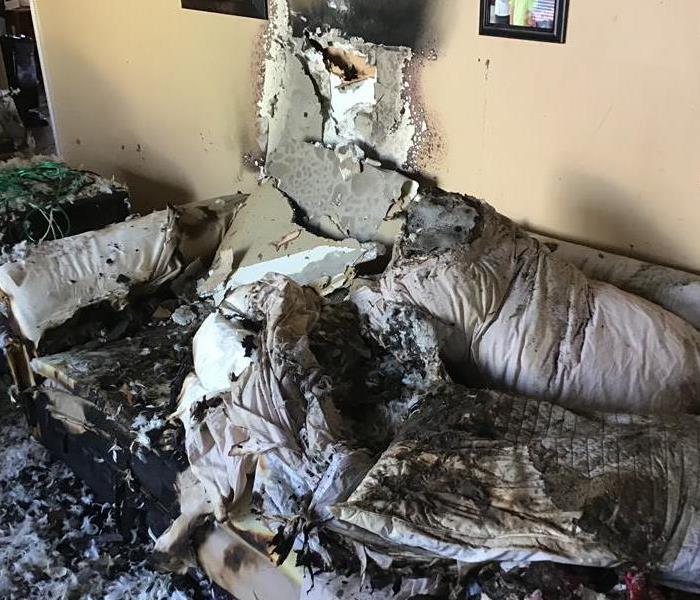 The couch that was caught on fire.
The couch that was caught on fire.
A fire can start in many ways, a kitchen fire, bad wiring, or maybe even a candle. For this case a candle was knocked over by a cat and burned a couch. The couch catches on fire and burns a hole in the wall. The damage didn't stop there. Smoke damage and soot was though out the house. SERVPRO team arrived on site to began the clean up. Over the next couple days, the SERVPRO team began to box up all items into boxes and brought to the warehouse for deep cleaning. On site was a full house cleaning, removing any soot and smoke damage to the house. Walls and ceilings were sponged to removed soot and wet cleaned with SERVPRO approved cleaning products. Back at the warehouse, each boxed is opened and cleaned deeply. Once all is set and done with approval of the customer. The house was back to normal. "Like it never even happened."
Fire Damage can behind in plain sight
3/27/2019 (Permalink)
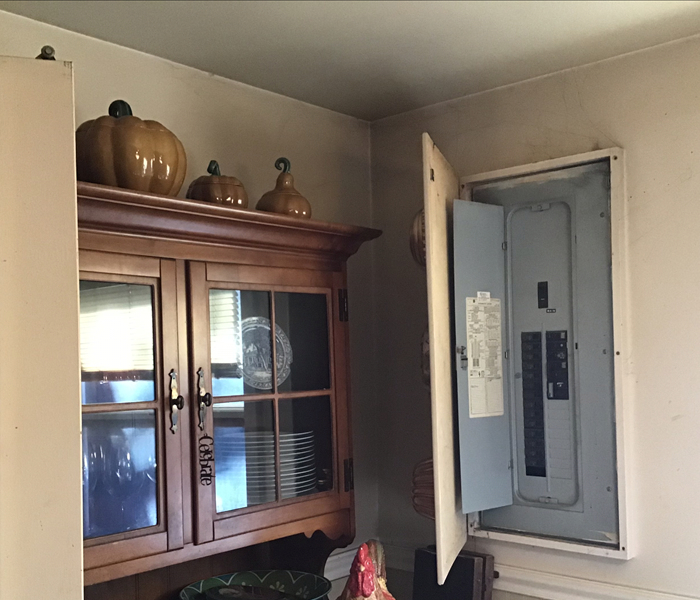 Soot can be seen almost everywhere
Soot can be seen almost everywhere
If you had a fire, you might have cleaned up anything damage of any soot or brunt items. However that does not mean you are safe from breathing in soot or smoke for good. When a fire happens smoke and soot rises. So for example the fire happens in the kitchen and you live in a multi level home. The smoke and soot from that fire will rise and go the second or third floor of the home. Smoke rises, so drywall and content from above will be damaged. SERVPRO can come in and make sure the house is safe and protected from any safety hazards. SERVPRO will come in and remove smoke and soot from the home. SERVPRO does this by using sponges on the ceiling and walls to remove soot, then using chemicals cleaning the same. Content will be cleaned as well. SERVPRO is high skilled at cleaning and protecting a home.
Fire Job in a house of art
1/21/2019 (Permalink)
 The ceiling on the main floor the difference can me seen!
The ceiling on the main floor the difference can me seen!
When it comes to the hard working people of SERVPRO, we be sure when we work we do our best at making sure customers belongings are in the upmost care. When it comes to pack out from a fire job we take our time and put care in making sure the belongings are safe. A fire job done in Downers grove gave the SERVPRO a challenge to see how careful they are during pack out. The customer had smoke damage within her whole house. She also had lots of paintings and fragile belongings in her home. The SERVPRO team was extra careful during all of this. The Customer had flat paint so the smoke damage was heavy on the walls and ceiling. In the end after content cleaning,cleaning walls and cleaning (with sponges and chemicals) and lastly upholstery/carpet cleaning. The house was clean and walls and ceilings looked brand new. It was truly "Like it never even happened".
Fire Drills at Home Can Save Lives
5/21/2018 (Permalink)
Fire drills are not just for schools, they should be completed by business and families alike. It is crucial to the safety of all that everyone knows more than one way out of the building or home, the designated meeting spot a safe distance from the structure where a head count can be taken to inform first responders of anyone left in the building and what to do should they not be able to have an escape route. We like to suggest that customers regularly perform a “fire drill” so that everyone knows what to do and how to keep themselves and others safe. If disaster should strike your home, we are ready 24/7, 365 at 630-771-1720 to help walk with you through the cleanup and repairs to help you make it “Like it never even happened.”
Fire Extinguisher Knowledge- Part 2
5/12/2018 (Permalink)
This blog post is a continuation of "Fire extinguisher knowledge part one" from our website.
The fourth type of fire extinguisher is the wet chemical extinguisher. The wet chemical extinguisher helps in that it focuses on removing heat from the fire in order to extinguish a fire and is most effective on fires made from paper, wood or plastics.
The fifth type of extinguisher is the clean agent. This type of extinguisher focuses on breaking the chemical reaction of a fire and is best worked on fires caused by flammable liquids, electrical equipment or combustibles such as wood or trash.
The sixth type is the dry powder extinguisher which focuses on separating the oxidizing agent from the fuel source and is most useful on fires created by combustible metals.
The seventh is the water mist extinguisher. This extinguisher is mainly water and focuses on cooling the fire and adds a cleaning agent to simplify the mess and should mainly be used on fires caused by electrical content.
The eighth and final extinguisher is the cartridge operated dry chemical and is similar to the clean agent in that it interrupts the chemical reaction of the fire
Fire Extinguisher Knowledge- Part 1
5/7/2018 (Permalink)
In the case of a fire emergency, both knowing general facts and tips on fire extinguishers can help exponentially when putting out any kind of fire. This will be one of two blogs explaining the facts on extinguishers.
The different types of extinguishers.
In total there are eight different types of fire extinguishers, the first is water and foam based. This type focuses on taking the heat element out of a fire and should mainly used on a fire made from wood, paper or plastic.
The second type of extinguisher is carbon dioxide based that focuses on taking away the oxygen element of a fire, and should only be used on fires made from flammable liquids such as gas or oil, or fires from electrical equipment such as outlets or transformers.
The third is a dry chemical extinguisher. This type is the most common of extinguishers and focuses on interrupting the chemical reaction of a fire triangle. (The fire triangle is what makes up a fire; Heat, Fuel, and an oxidizing agent which is normally oxygen) This extinguisher should be mainly used on; material fires caused from wood or plastic, fire caused from a flammable liquid such as gas, and fires made from electrical equipment.
Smoke or Soot Damage in Bolingbrook IL
3/7/2018 (Permalink)
Clean Up from Fire & Smoke Damage Calls for Professional Help
Dealing with soot is one of the most time-consuming parts of fire damage restoration. Residue quickly settles on all kinds of surfaces after a fire, and the cleanup is a genuine struggle for homeowners who are dealing with the aftermath of a blaze. However, what is soot, and why does it form after the fire?
Soot is the fine brown or black powder that clings to and discolors surfaces in the home after fire damage. Soot is what gives items that charred and blackened look. Smoke is a by-product of the incomplete combustion of materials; as wood, paper, plastic and other materials burn during a house fire, they produce residues and release particles into the atmosphere.
The composition of soot makes it slightly sticky, which means it clings to surfaces and is difficult to remove. A smoke-damaged house does not feel like a home, SERVPRO will help with fire damage cleanup and restore your home “Like it never even happened.”
Our highly trained technicians arrive ready to thoroughly assess your property and devise the best cleaning plan for you. We advise you on which items are salvageable from soot damage and which are not.
If your home has soot, smoke and fire damage call SERVPRO of Woodridge/Bolingbrook at 630-771-1720
How To Prevent Dryer Vent Fires
3/1/2018 (Permalink)
Facts about home clothes dryer fires
- 2,900 home clothes dryer fires are reported each year and cause an estimated 5 deaths, 100 injuries, and $35 million in property loss.
- Failure to clean the dryer (34 percent) is the leading cause of home clothes dryer fires.
- More home clothes dryer fires occur in the fall and winter months, peaking in January.
Clothes dryer fire safety messages
It is important for community residents to know how to keep themselves safe from fire. Use the following fire safety messages to teach people about clothes dryer fire safety.
Clothes dryer do’s
Installation
- Have your clothes dryer installed by a professional.
- Make sure the correct electrical plug and outlet are used and that the dryer is connected properly.
- Read manufacturers' instructions and warnings in use and care manuals that come with new dryers.
Cleaning
- Clean the lint filter before and after each load of laundry. Don’t forget to clean the back of the dryer where lint can build up. In addition, clean the lint filter with a nylon brush at least every six months or more often if it becomes clogged.
- Clean lint out of the vent pipe every three months.
- Have your dryer cleaned regularly by a professional, especially if it is taking longer than normal for clothes to dry.
Maintenance
- Inspect the venting system behind the dryer to ensure it is not damaged or restricted.
- Put a covering on outside wall dampers to keep out rain, snow and dirt.
- Make sure the outdoor vent covering opens when the dryer is on.
- Replace coiled-wire foil or plastic venting with rigid, non-ribbed metal duct.
- Have gas-powered dryers inspected every year by a professional to ensure that the gas line and connection are together and free of leaks.
- Check regularly to make sure nests of small animals and insects are not blocking the outside vent.
- Keep the area around the clothes dryer free of items that can burn.
- If you will be away from home for an extended time, unplug or disconnect the dryer.
Clothes dryer don’t's
- Don’t use a clothes dryer without a lint filter or with a lint filter that is loose, damaged or clogged.
- Don’t overload the dryer.
- Don’t use a wire screen or cloth to cover the wall damper. They can collect lint and clog the dryer vent.
- Don’t dry anything containing foam, rubber or plastic. An example of an item not to place in a dryer is a bathroom rug with a rubber backing.
- Don’t dry any item for which manufacturers' instructions state “dry away from heat.”
- Don’t dry glass fiber materials (unless manufacturers' instructions allow).
- Don’t dry items that have come into contact with anything flammable like alcohol, cooking oils or gasoline. Dry them outdoors or in a well-ventilated room, away from heat.
- Don’t leave a clothes dryer running if you leave home or when you go to bed.
Need Dryer Vent Cleaning? Call SERVPRO of Woodridge/Bolingbrook at 630-771-1720
4 Furnace Safety Tips for Winter
12/28/2017 (Permalink)
As the cold winter months approach us, most of us turn to our furnace to keep our homes cozy and warm. Although furnaces are a great way to heat our homes, there are some precautions that we should take to safely operate our furnaces and avoid problems in the long run.
Start the year off right with the following furnace safety tips:
1. CHANGE YOUR AIR FILTER
It is important to change your furnace filter regularly. A clean air filter will help your furnace burn more efficiently and will help keep dust from being circulated through your home. A dirty filter can cause a number of efficiency, performance and safety issues, as well as result in furnace failure. Change or clean your air filter every 1-3 months during the winter when the furnace is being used the most.
2. ANNUAL FURNACE CHECK-UP
Have your furnace cleaned and checked every year by a professional. An annual furnace check-up is essential to make sure that the system is working well and operating efficiently. During the inspection, your furnace will be checked for problems such as carbon monoxide leaks or frayed electrical wires that could lead to safety hazards in your home.
3. TEST YOUR CARBON MONOXIDE DETECTORS
If your furnace isn’t functioning properly, one of the biggest threats that it can impose to your home is a carbon monoxide leak. Carbon monoxide is a type of gas that is colorless and odorless, so there is no way to detect high levels of it on your own. A carbon monoxide leak can cause us to have flu-like symptoms, disorientation, confusion and even death. It is imperative to check that all of your home’s carbon monoxide detectors are working properly.
4. KEEP THE AREA AROUND YOUR FURNACE CLEAR
In order to minimize the chance of a fire, it would be smart to keep the area around your furnace clear. Flammable products such as papers, sawdust, old rags and wood scraps should be kept a safe distance away from the furnace. Liquids such as gasoline and kerosene should be stored in tightly sealed containers, since vapors from flammable liquids easily ignite.
Wishing You a Safe and Happy Holiday Season
12/20/2017 (Permalink)
Please keep these Christmas Tree Fire Safety Tips in mind during this holiday season!
1. Choose a tree with fresh, green needles that do not fall off when touched.
2. Place your tree it at least three feet away from any heat source including your fire place, heaters and candles (or anything that can dry out the tree and make it more flammable).
3. Always keep your tree stand filled with water.
4. When decorating your tree replace any string of lights with worn or broken cords or loose bulb connections. Connect no more than three strands of mini string sets and a maximum of 50 bulbs for screw-in bulbs. Read manufacturer’s instructions for number of LED strands to connect.
5. Make sure your smoke alarms and carbon monoxide detectors are operating properly.
6. Try not to leave your tree up for more than two weeks.
7. Never leave Christmas tree lights on if the tree is unattended. Unplug them when you go to bed or leave the home.
8. When purchasing an artificial tree, be sure it is labeled as fire-retardant.
Have a safe and joyful holiday season!!
Smoke Alarms Are Important
12/7/2017 (Permalink)
 Test Your Smoke Alarms Regularly
Test Your Smoke Alarms Regularly
Smoke alarms are a key part of a home fire escape plan. When there is a fire, smoke spreads fast. Working smoke alarms give you early warning so you can get outside quickly.
- A closed door may slow the spread of smoke, heat and fire. Install smoke alarms in every sleeping room and outside each separate sleeping area. Install alarms on every level of the home. Install alarms in the basement. Smoke alarms should be interconnected. When one sounds, they all sound.
- Large homes may need extra smoke alarms.
- It is best to use interconnected smoke alarms. When one smoke alarm sounds they all sound.
- Test all smoke alarms at least once a month. Press the test button to be sure the alarm is working.
- There are two kinds of alarms. Ionization smoke alarms are quicker to warn about flaming fires. Photoelectric alarms are quicker to warn about smoldering fires. It is best to use of both types of alarms in the home.
- A smoke alarm should be on the ceiling or high on a wall. Keep smoke alarms away from the kitchen to reduce false alarms. They should be at least 10 feet (3 meters) from the stove.
- People who are hard of hearing or deaf can use special alarms. These alarms have strobe lights and bed shakers.
- Replace all smoke alarms when they are 10 years old.
- Smoke alarms are an important part of a home fire escape plan.
What to Do Before and After a Fire
5/30/2017 (Permalink)
After any fire damage situation, your primary focus should be safety first:
- Is it safe to stay in the house?
- Electrical and "slip and fall" hazards are some of the most prevalent concerns.
- Only do activities that are safe for you to perform.
- Wet materials can be VERY heavy. Be careful!
Have Smoke or Fire Damage? Call (630) 771-1720
What To Do After A Fire
- Limit movement in the home to prevent soot particles from being embedded into upholstery and carpets.
- Keep hands clean so as not to further soil upholstery, walls and woodwork.
- Place clean towels or old linens on rugs, upholstery and carpet traffic areas.
- If electricity is off, empty freezer and refrigerator and prop doors open.
- Clean and protect chrome with light coating of petroleum jelly or oil.
- Wash houseplants on both sides of leaves.
- Change HVAC filter.
- Tape double layers of cheesecloth over air registers.
What NOT To Do After A Fire
- Don't attempt to wash any walls or painted surfaces or shampoo carpet or upholstery without contacting us.
- Don't attempt to clean any electrical appliances that may have been close to fire, heat or water without consulting an authorized repair service.
- Don't use any canned or packaged food or beverages that may have been stored near the fire, heat or water.
- Don't turn on ceiling fixtures if ceiling is wet. The wiring may be damaged.
- Don't send garments to an ordinary dry cleaner. Improper cleaning may set smoke odor.
Home Fire Safety
5/30/2017 (Permalink)
Did you know that if a fire starts in your home you may have as little as two minutes to escape? During a fire, early warning from a working smoke alarm plus a fire escape plan that has been practiced regularly can save lives. Learn what else to do to keep your loved ones safe!
Top Tips for Fire Safety
Install smoke alarms on every level of your home, inside bedrooms and outside sleeping areas.
Test smoke alarms every month. If they’re not working, change the batteries.
Talk with all family members about a fire escape plan and practice the plan twice a year.
If a fire occurs in your home, GET OUT, STAY OUT and CALL FOR HELP. Never go back inside for anything or anyone.
If a Fire Starts:
- Know how to safely operate a fire extinguisher
- Remember to GET OUT, STAY OUT and CALL 9-1-1 or your local emergency phone number.
- Yell "Fire!" several times and go outside right away. If you live in a building with elevators, use the stairs. Leave all your things where they are and save yourself.
- If closed doors or handles are warm or smoke blocks your primary escape route, use your second way out. Never open doors that are warm to the touch.
- If you must escape through smoke, get low and go under the smoke to your exit. Close doors behind you.
- If smoke, heat or flames block your exit routes, stay in the room with doors closed. Place a wet towel under the door and call the fire department or 9-1-1. Open a window and wave a brightly colored cloth or flashlight to signal for help.
- Once you are outside, go to your meeting place and then send one person to call the fire department. If you cannot get to your meeting place, follow your family emergency communication plan.
-
If your clothes catch on fire:
- Stop what you’re doing.
- Drop to the ground and cover your face if you can.
- Roll over and over or back and forth until the flames go out. Running will only make the fire burn faster.
THEN:
Once the flames are out, cool the burned skin with water for three to five minutes. Call for medical attention.
HVAC Fire Hazards and Prevention
5/15/2017 (Permalink)
The Top HVAC Fire Hazards
HVAC systems are usually in a back room of the basement, outside behind the house, or in the attic – three places that are easy for homeowners to forget about.
Regardless of the season, HVAC fire hazards are present at any time of the year. Fortunately, many of these risks are preventable.
The Top HVAC Fire Hazards:
- HVAC parts are old, corroded, or broken:This problem often stems from an HVAC unit that is not regularly serviced. Problems with essential parts can lead to decreased efficiency and also lead to potential fire hazards.
- Items are stored too close to the HVAC unit:The HVAC unit itself produces a considerable amount of heat. Storing combustible items such as boxes, paper, motor oil, and chemicals too close to the unit creates a high-risk environment for a fire.
- Problems with connections or gas pressure:Problems with connections in a gas furnace can lead to toxic gas being released into the home, leading to both health and fire hazards.
- The HVAC unit has an electrical problem: Whether the unit has a loose cord connection, a frayed cord, an old cord that overheats, or another issue, electrical problems with HVAC units can easily spark furnace fires.
- A fuel line is leaking: This can be a harder problem to spot since many fuel lines are located inside or behind the unit. Yearly inspections can help catch old, at-risk fuel lines before they start leaking and posing a major fire hazard.
- Improper installation: When an HVAC unit is installed improperly, it can lead to many problems such as reduced air flow and efficiently, and increased costs. Improper installation can also cause serious problems such as carbon monoxide poisoning and fire hazards.
If you notice the smell of gas in the basement, evacuate the home and call your service technician immediately.
What You Can Do to Prevent HVAC Fires
Taking steps to prevent HVAC fires is the best way to avoid an emergency situation. In addition, these steps can save you a lot of long-term hassle and cost.
Tips for Preventing HVAC Fires:
- Schedule HVAC maintenance at least once a year.Not only is a yearly inspection a good way to ensure that every part is in serviceable condition, you can maintain optimal efficiency for energy savings.
- Don’t attempt DIY HVAC maintenance. Always hire a professional, certified technician to perform any repairs or tune-ups on your HVAC unit. DIY repairs can lead to accidental problems such as carbon monoxide poisoning or increased risk of fire hazards.
- Ensure that the area is properly ventilated.HVAC systems produce carbon monoxide, a toxic, invisible, odorless gas. Without proper ventilation, this gas can collect in the home and become extremely hazardous to occupants.
- Be aware of what you store near your HVAC unit.It is advised to keep all items at least 3 feet away from the unit. Much like portable heaters and other appliances, HVAC units can get extremely hot and cause flammable items to combust. Storing items too close to heating equipment is one of the primary causes of home fires.
- Replace the filters on your HVAC at least twice a year, if applicable.Set a routine that is easy to remember, such as once during the spring and again during the fall. Not only will a filter improve the air quality in your home, it will help ensure proper airflow and reduce overheating.
- If you have an outdoor HVAC unit and keep it covered during certain seasons, make sure to remove the cover prior to the first use of the season. An obstructed airflow can cause overheating and pose a fire hazard.
- Install a carbon monoxide detector near the HVAC unit.Evacuate the home and call your HVAC technician if the alarm goes off.
Now that you know the top HVAC fire hazards and how to prevent them, you can take steps to keep your family safe year-round.
Bolingbrook Smoke and Soot Clean-Up
12/8/2016 (Permalink)
Smoke and soot is very invasive and can penetrate various cavities within your home, causing hidden damage and odor. Our smoke damage expertise and experience allows us to inspect and accurately assess the extent of the damage to develop a comprehensive plan of action.
Smoke and soot facts:
- Hot smoke migrates to cooler areas and upper levels of a structure.
- Smoke flows around plumbing systems, seeping through the holes used by pipes to go from floor to floor.
- The type of smoke may greatly affect the restoration process.
Different Types of Smoke
There are two different types of smoke–wet and dry. As a result, there are different types of soot residue after a fire. Before restoration begins, SERVPRO of Woodridge/Bolingbrook will test the soot to determine which type of smoke damage occurred. The cleaning procedures will then be based on the information identified during pretesting. Here is some additional information:
Wet Smoke – Plastic and Rubber
- Low heat, smoldering, pungent odor, sticky, smeary. Smoke webs are more difficult to clean.
Dry Smoke – Paper and Wood
- Fast burning, high temperatures, heat rises therefore smoke rises.
Protein Fire Residue – Produced by evaporation of material rather than from a fire
- Virtually invisible, discolors paints and varnishes, extreme pungent odor.
Our Fire Damage Restoration Services
Since each smoke and fire damage situation is a little different, each one requires a unique solution tailored for the specific conditions. We have the equipment, expertise, and experience to restore your fire and smoke damage. We will also treat your family with empathy and respect and your property with care.
Locally Owned Company with National Resources
SERVPRO of Woodridge / Bolingbrook is locally owned and operated and we are proud to be part of this community. We are also part of a national network of over 1,700 Franchises with special Disaster Recovery Teams placed strategically throughout the country to respond to large-scale fire, water, and storm disasters.
Have Questions about Fire, Smoke, or Soot Damage?
Call Us Today –630-771-1720





 24/7 Emergency Service
24/7 Emergency Service









